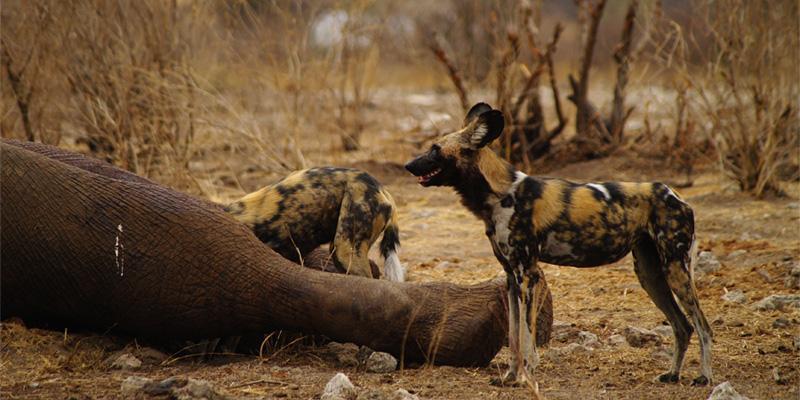
Khaudum National Park
Wild and wildlife-rich national park
The unique Khaudum National Park is located in the north-east of Namibia, directly on the border with Botswana and at the entrance to the Zambezi region (formerly the Caprivi Strip). The park has an area of approx. 3900 km² and is in the so-called Kalahari Sandveld, i.e. it is a semi-desert area. From Tsumkwe the park can be reached in a northerly direction after about 65 km.
Specifications
The Khaudum: A national park exclusively for off-road vehicle enthusiasts
Khaudum National Park is considered one of the wildest national parks in Namibia. A well-suited off-road vehicle is necessary. It is recommended that you only explore the park in a group with at least two vehicles. You should also take enough water, fuel and equipment for sand trips.
Reaching the park from the south (from Tsumkwe) is easy. It takes about 1 hour to cover the 65 km. The journey from the north into the park via the B8 between Rundu and Divundu is very sandy for long stretches and takes a very long time of around 3 hours for just 45 km.
Also, in the Khaudum National Park, almost all “roads” consist of soft sand and are difficult to navigate, especially in summer and when it is hot (so most the times). After rain, the tracks become even more difficult to drive. The following applies: Many tracks in a horizontal direction (i.e. from west to east and vice versa), especially along the omurambas (dry riverbeds), are easy to drive on, with a few exceptions. All tracks that run from north to south (or vice versa) are very sandy and are sometimes so rutted that at speeds higher than 15 km/h, even with off-road vehicles that have high ground clearance, you can occasionally touch ground.
You need time and patience for the Khaudum and if you bring both along, you will be rewarded with a great nature experience.
Specialties and wildlife of Khaudum National Park
Since the Khaudum National Park is not fenced, the animals can roam freely according to their habits.
The park is very rich in game, there are large herds of elephants, for instance. Through game counts it was determined that there are between 6,400 and 8,000 elephants in Khaudum at times. They regularly visit the well-developed waterholes (with viewing platforms), especially in the dry season, and can be observed here undisturbed.
In addition to the elephants, the Khaudum is known for the large packs of African wild dogs. These are among Africa's most critically endangered predators. The packs are not shy, but you still need a bit of luck to spot them. It is advisable to look out for tracks of predators on the sandy paths of Khaudum.
There are also many giraffes, antelopes, especially the rare roan antelope, lions, hyenas, leopards, over 300 species of birds and much more.
Many waterholes have viewing platforms from which you can observe the animals outside the vehicle, well protected from the sun and weather.
Accommodation in Khaudum National Park
After there had been problems with reliable booking for accommodation in Khaudum for a long time and the Sikereti campsite had fallen into disrepair, both camps have been accessible again since 2023, can be pre-booked and are of very good quality.
Sikereti camp
Sikereti Camp in the southern part of Khaudum offers rustic accommodation in 8 safari tents and 4 campsites. Sikereti is idyllically located in a dense forest about 7 km north of the southern entrance gate to Khaudum National Park.
Khaudum Camp
The Khaudum campsite was privatized and completely renovated in 2015. Khaudum Campsite offers 6 campsites under shade trees on a prehistoric dune. From the campsites you have a beautiful view of the Khaudum Omuramba. Each campsite has its own barbecue area and private toilet and shower cabins.
Khaudum map
Here you can download the map
Recommended route through Khaudum National Park from south to north
- Day 1 - Arrival from Tsumkwe: Drive through the Sikereti Gate and pay the park entrance, overnight in Sikereti and possibly do an afternoon tour to the Tsoanafontein and Soncana waterholes. As an alternative to Sikereti, you can also stay overnight at the Living Hunter’s Museum’s Elephant Song Campsite, about 20 km south of Khaudum National Park.
- Day 2 - From Sikereti to Khaudum: Early departure and drive to the Soncana waterhole. Here through the Nhoma Omuramba to the Omuramba waterhole and further to the Dussi waterhole. From there via Tari Kora to the Leeupan waterhole. At the end of the day's journey north to Doringstraat and straight on to Khaudum Omuramba. From here it is not far to Khaudum Camp. The travel time for these 100km is around 6-7 hours.
- Day 3 - Game drive in northern Khaudum: In the morning you can visit the Burkea waterhole, which is often full of elephants, and have a picnic on the viewing platform. Back to camp during hot lunchtime and in the evening along the Khaudum Omuramba in search of wild animals. There are also often many sighting opportunities at the Khaudum waterhole.
- Day 4 - Departure from Khaudum Camp: From Khaudum Camp east into Khaudum Omuramba to the junction into Cwiba Omuramba. Keep left here and continue this beautiful route west to the Khaudum reception. Travel time 1.5 hours. Now continue along the northern route to Katere on the B8. For the last 45 km the journey time is around 3 hours.
Of course you can also drive the route from north to south.







